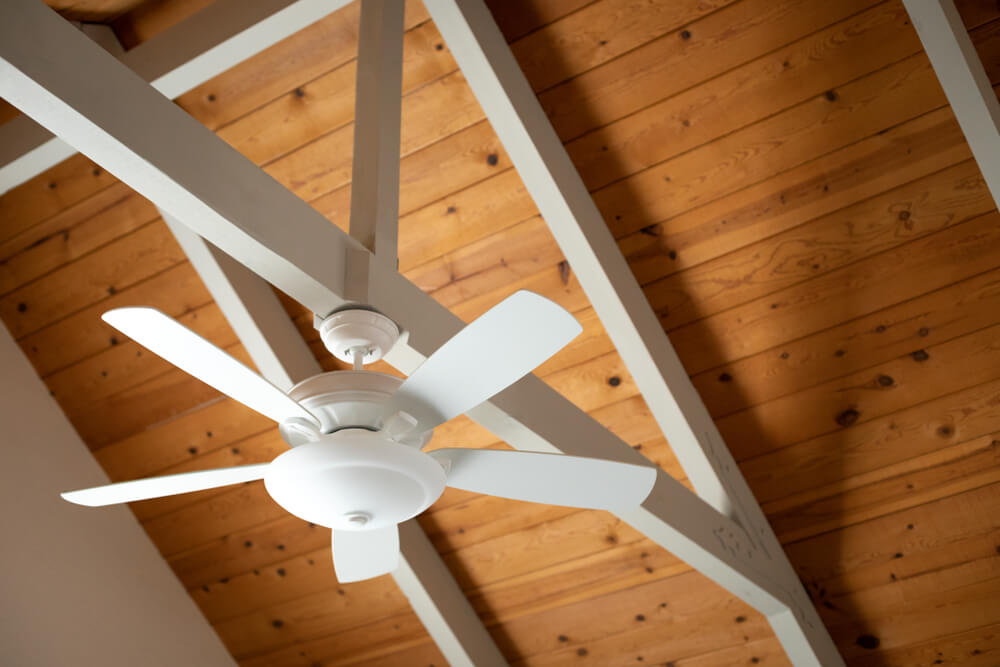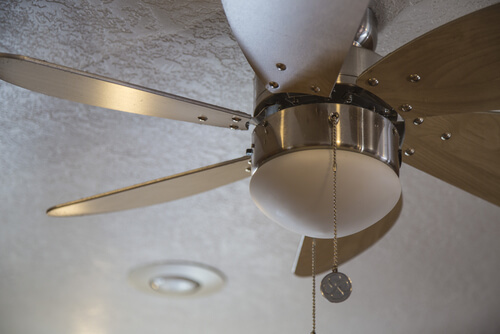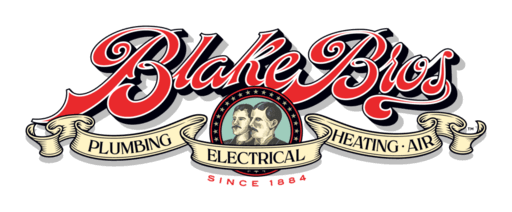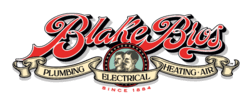Everything You Need to Know About Ceiling Fan Installation

Ceiling fans serve some important functions throughout your home. Their main job is to distribute air throughout a room, avoiding any stagnant air in the home, which can lead to many problems like stuffiness, odors, and the accumulation of indoor pollutants.
In concert with heating and AC systems, ceiling fans are also useful for enhancing energy efficiency in the home. Set your thermostat a few degrees higher in the summer or lower in the winter to reduce overall energy consumption and further lower your utility bills.
Additionally, many ceiling fans come equipped with built-in lighting fixtures, providing both illumination and air circulation in one piece of equipment. Installing a ceiling fan with a light is especially convenient for smaller rooms with no extra space for fans and lighting fixtures.
6 Factors to Consider Before Installing a New Ceiling Fan
There is quite a selection of different makes and models of ceiling fans on the market. With so many choices, finding one within your budget and aesthetic should be easy enough. Here are six factors to consider if you’re thinking about installing a ceiling fan.
1. Budget
Finding a ceiling fan that fits your home’s needs, budget, and interior design is essential to staying happy with your hopefully long-lasting decision. A standard ceiling fan will typically last ten years, depending on wear and tear, so setting a budget is important to ensure you don’t get the cheapest ceiling fan that might not last you as long. Setting a reasonable budget also ensures you aren’t breaking the bank.
2. Size

The size of your ceiling fan is crucial for its effectiveness in cooling your home. Now, you might be wondering how to measure the right ceiling fan size and how to determine what size ceiling fan to buy. The size of a ceiling fan is typically measured by the diameter of the fan blades, and it is expressed in inches. The size directly impacts the fan’s ability to move air and create a comfortable environment.
3. Cubic Feet of Airflow per Minute (CFM)
CFM is a measure of the volume of air a ceiling fan can move in one minute. Larger fans typically have a higher CFM rating, indicating their ability to move more air. A ceiling fan’s CFM should be appropriate for the room size to ensure effective cooling.
4. Motor
The primary function of the ceiling fan’s motor is to drive the rotation of the fan blades. The motor converts electrical energy into mechanical energy, causing the blades to spin. The speed and power of the motor determine how fast and effectively the blades move, influencing the airflow and cooling capacity of the fan.
The quality of the motor can also influence the noise level of the fan while it’s on. High-quality motors are designed to operate quietly, providing a comfortable and peaceful home environment. Additionally, some motors are reversible, allowing the ceiling fan to operate in both clockwise and counterclockwise directions. This feature is useful for winter heating as it helps distribute warm air evenly.
5. Number and Angle of Blades

The number and angle of blades on a ceiling fan can have an impact on its performance, efficiency, and aesthetics. Most modern residential fans have a range of two to nine blades. The number of blades really comes down to your personal preference and style. It’s the motor and angle of the blades that really affect the airflow.
A fan with fewer blades tends to move more air than those with a higher number of blades. This is because fewer blades put less pressure on a traditional motor and create more powerful airflow. The difference in airflow is also influenced by other factors like motor power, the overall design of the fan, and the angle or pitch of the blades. A steeper blade pitch can move more air, making the fan more effective at creating a breeze and providing better cooling.
6. Energy Efficiency
Fans with fewer blades tend to be more energy-efficient. While the number of blades is just one factor, fans with three or four blades are often more efficient in terms of moving air with less resistance compared to fans with a higher number of blades.
Additionally, choosing a fan that is appropriately sized for the room is essential for energy efficiency. An oversized ceiling fan may consume more energy than necessary, while an undersized fan may need to operate at higher speeds to provide sufficient airflow.
Ceiling Fan Installation Cost
The cost of ceiling fan installation can vary based on several factors, including the complexity of the installation, location, and features that specific fan comes with. Here’s a breakdown of the different types of ceiling fans and their costs to install:
- Damp-rated: $125 to $1,100
- Directional: $150 to $800
- Dual-Motor/Rotational: $200 to $1,500
- Energy Star Certified: $60 to $600
- Hanging Propeller: $150 to $550
- Low-Profile: $50 to $300
- Smart Fan: $120 to $1,000
- Standard: $50 to $300
- Wet-Rated: $150 to $1,200
Can I Install a Ceiling Fan Myself?
Anyone can install a ceiling fan, but that doesn’t mean that everyone can do so safely. The ceiling fan will need to attach to the correct wires, of which there are several. If you don’t have wires where you want to install your ceiling fan, those have to be run from the circuit.
Remember that there is always a risk when you deal with electricity, and safety precautions should be taken. Skip all that hassle and have a professional electrician do it for you. The electricians at Blake Brothers know how to wire new ceiling fans and guard against fire risks.
Contact Blake Brothers for ceiling fan installations in Huntsville, Alabama, and surrounding areas.

